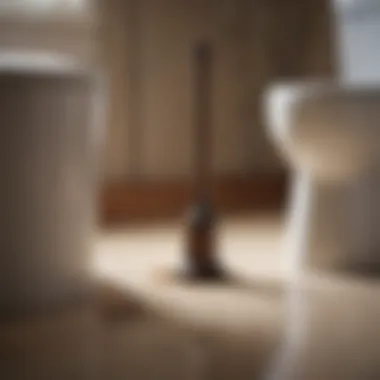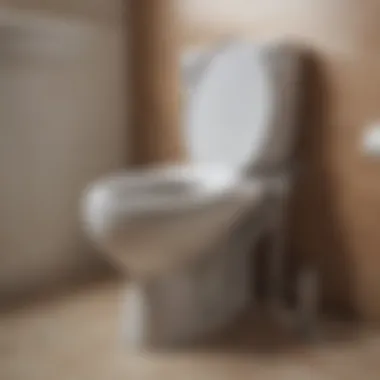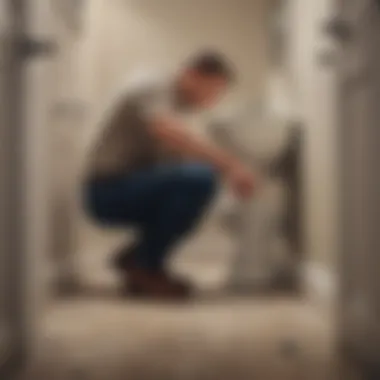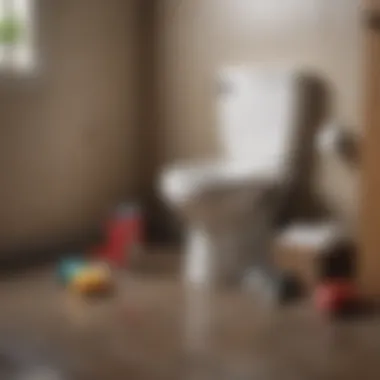Effective Strategies for Unclogging a Toilet


Intro
Clogged toilets present a common problem that can disrupt daily life. Despite the inconvenience, understanding how to effectively tackle this issue can save considerable time and frustration. Recognizing the underlying cause of the blockage is essential for choosing the right unclogging strategy. The methods available can range from traditional plumbing tools to modern approaches that employ innovative techniques. This article aims to provide a thorough guide to address toilet clogs efficiently, ensuring readers are equipped with practical information that promotes safety and effectiveness.
Understanding the Causes of Toilet Clogs
To effectively unclog a toilet, one must first identify the primary causes of the blockage. Several factors can contribute to this issue:
- Excessive toilet paper use: Using too much toilet paper in a single flush can lead to clogs.
- Foreign objects: Items inadvertently dropped into the toilet, such as toys or hygiene products, can create blockages.
- Low-quality plumbing: Poorly designed plumbing systems may struggle with drainage, leading to clogs.
Identifying the cause will guide the choice of unclogging methods that are best suited for the situation.
Traditional Methods for Unclogging a Toilet
Numerous tried-and-true techniques remain reliable for unclogging toilets. When applying these methods, one must approach with careful consideration of safety and effectiveness.
Using a Plunger
The plunger is a common household tool for resolving clogs. Using it effectively requires some specific steps:
- Choose the right plunger: A flange plunger is designed for toilets and provides a better seal.
- Create a seal: Place the plunger over the drain hole to ensure no air escapes.
- Pump vigorously: Push down gently at first, then increase the force of your thrusts. Ensure you pull back on the upward stroke as well.
- Check for drainage: After multiple thrusts, see if the water drains properly.
Wet/Dry Vacuum
If a plunger fails, consider a wet/dry vacuum. This approach requires:
- Suction capability: Ensure the vacuum can handle liquids.
- Sealing the drain: Create a tight seal with the hose over the drain.
- Sucking the blockage: Turn on the vacuum for a few moments. This may dislodge the clog effectively.
Modern Techniques for Unclogging a Toilet
The evolution of plumbing technology has introduced efficient alternatives. These methods can be more effective than traditional approaches in certain situations.
Enzymatic Drain Cleaners
These cleaners contain bacteria that digest organic matter, effectively clearing clogs over time. While they provide a less hands-on approach, patience is key. Follow product instructions for successful application.
Plumbing Snake
A plumbing snake or auger can reach deeper blockages than a plunger. To use a plumbing snake:
- Insert the snake: Slide the snake into the toilet drain and turn the handle to extend it deeper.
- Rotate and push: As you rotate, push the snake further until you feel resistance.
- Break apart the blockage: Continue twisting and pushing until you feel the clog break apart.
Prevention Tips
Preventing toilet clogs is often easier than dealing with the aftermath. Here are some proactive measures:
- Limit toilet paper usage: Only use what is necessary.
- Educate family members: Ensure everyone understands what should not go down the toilet.
- Regular maintenance: Flush hot water through the lines occasionally, which can help break down any build-up over time.
"An ounce of prevention is worth a pound of cure!"
Benjamin Franklin
The End
Effectively unclogging a toilet requires understanding the cause of the blockage and choosing the appropriate method. From traditional tools like plungers to modern solutions like enzymatic cleaners, there are myriad ways to tackle this common household issue. By following the steps outlined in this article, readers can resolve clogs efficiently while also taking preventive measures to minimize future hassles.
Understanding Toilet Clogs
Understanding toilet clogs is paramount for efficiently resolving these common issues. Recognizing what contributes to clogs supports not only effective unclogging strategies but also prevention. Awareness of clog origins allows homeowners and renters to manage and mitigate problems before they escalate.
Common toilets use water efficiently, but over time, waste material can accumulate due to various factors. Identifying these causes reduces frustration when the inevitable blockage occurs. This knowledge equips individuals to act swiftly and correctly, minimizing damage and inconvenience while promoting a sense of control over household maintenance.
Common Causes of Clogs
Excessive Toilet Paper
Excessive toilet paper is a significant contributor to toilet clogs. Many users underestimate how much toilet paper is too much. It absorbs water and swells, leading to greater bulk in the plumbing system. This can restrict water flow and cause potential backups.


The key characteristic of excessive toilet paper is its tendency to clump when wet. While it is a common choice due to its softness and comfort, using too much can lead to frustration during the toilet use. A unique feature of toilet paper is its design for ease of use, but excessive amounts can negate this benefit, resulting in costly and irritable blockages.
Foreign Objects
Foreign objects refer to items not meant for toilets that become lodged in the drainage system. This may include toys, feminine hygiene products, or anything mistakenly flushed. The presence of these items can abruptly disrupt waste flow, leading to clogs.
A crucial aspect of foreign objects is their unexpected nature. Even small items can cause significant problems. Their unique feature is the unpredictability of what may be flushed. While these objects can disrupt normal function, awareness among household members can reduce occurrences significantly.
Pipe Problems
Pipe problems can arise from a variety of issues including aging pipes, incorrect installation, or corrosion. These issues can create irregularities in the flow path, leading to areas where debris can accumulate.
The key characteristic of pipe problems is gradual deterioration, often unnoticed until it manifests as a severe clog. This can become a costly issue over time if not addressed. A unique feature is that some problems are not caused directly by the users but by the nature of plumbing materials. Being informed about pipe health is vital for preventing future clogs and maintaining plumbing integrity.
Identifying Clog Severity
Understanding how to identify the severity of a clog is crucial. This process involves evaluating specific indicators that help in deciding on the appropriate action.
Water Levels in the Bowl
Water levels in the toilet bowl can provide immediate indicators of clog severity. A high water level often shows that the toilet is struggling to drain effectively. This visual cue prompts investigation into the cause of the blockage.
A key characteristic of water levels is their ability to fluctuate based on the severity. A normal level is low, indicating a functioning system, while excessive levels signal trouble. Monitoring these changes is beneficial for immediate response to emerging issues.
Unusual Sounds
Unusual sounds during the flushing process can signify underlying problems. Gurgling or bubbling often indicates air trapped in the pipes, suggesting a blockage.
The crucial characteristic is that these sounds can serve as early warnings. They aren't commonly noted, but their presence suggests a need for action. Recognizing these auditory signs might prevent complete blockage, allowing for timely intervention and saving costs.
Previous Clog History
Previous clog history offers insight into patterns that may exist within plumbing systems. If a toilet clogs frequently, this becomes a symptom of deeper issues at play.
Key to this aspect is understanding patterns of clogs based on past experiences. If the same toilet consistently has trouble, addressing the underlying issues becomes essential. This unique feature aids in identifying potential problems early, allowing for preemptive measures before a simple clog evolves into a serious plumbing emergency.
Understanding these elements of toilet clogs is essential for maintaining home plumbing health. By recognizing causes and symptoms early, you can effectively manage risks and costs.
Basic Tools for Unclogging
To effectively address toilet clogs, understanding and utilizing the proper tools is essential. Each tool has its own function and application, allowing for diverse approaches to resolving this common issue. Knowing which tool to use can save time and reduce frustration, making the unclogging process smoother. This section outlines the tools that are fundamental in dealing with toilet clogs and emphasizes their specific benefits.
Plungers
Types of Plungers
There are several types of plungers designed for different scenarios. The two main types are the cup plunger and the flange plunger. The cup plunger features a rubber cup at the end, which is ideal for most toilet clogs, as it creates a seal that allows for effective suction. The flange plunger, on the other hand, has an extended rubber piece that fits more securely into the toilet's drain. This unique feature provides better leverage and suction, making it a particularly beneficial option for toilets.
Using the appropriate plunger type can enhance the unclogging process. While the cup plunger is versatile, many users find the flange plunger performs better with stubborn clogs due to its design. However, having both types on hand can be advantageous, as different clogs may require different tools.
Technique for Effective Use
Employing the right technique with a plunger is crucial for achieving the desired results. First, ensure the plunger is aligned properly over the drain. A firm, consistent up-and-down motion, rather than a forceful thrust, is recommended. This technique helps build suction without damaging the toilet. Additionally, it's suggested to apply some water to the bowl if levels are low, as this can enhance the plunging effect.
The advantage of mastering this technique lies in its simplicity. Effective plunging requires minimal training but can yield quick results. Many users appreciate how little effort it takes to see immediate improvement, which can sometimes eliminate the need for more aggressive methods.
Toilet Augers
Definition and Functionality
Toilet augers are specialized plumbing tools that help break apart or retrieve clogs deep within the toilet's pipes. This tool consists of a long flexible cable that can navigate pipe bends and effectively clear blockages. The primary advantage of a toilet auger is its ability to reach obstructions that are not accessible with plungers. It is particularly valuable for persistent clogs that resist initial attempts at removal.
Toilet augers are designed to grip and break up tough clogs while minimizing the risk of damage to the toilet itself. This functionality makes them a popular choice for those dealing with frequent or severe clogs. However, familiarity with the tool is necessary; improper use can lead to complications.
Usage Guidelines


Using a toilet auger requires specific steps to maximize effectiveness. Start by inserting the auger into the toilet bowl, gently twisting the handle. As the cable advances, it will encounter resistance from the clog. Continuing to twist and push will either clear the clog or pull back a foreign object. Patience is key during this process, as excessive force can damage the plumbing.
These guidelines are beneficial as they help ensure the user achieves the desired outcomes without encountering complications. It is important to read the manufacturer's instructions before attempting to use an auger, as different models may vary in operation.
Chemical Drain Cleaners
Types of Chemicals
Chemical drain cleaners come in various formulations, primarily classified as alkaline, acidic, or enzymatic cleaners. Alkaline cleaners are commonly used to dissolve organic matter and grease. In contrast, acidic cleaners focus on breaking down harder materials like soap scum or calcium buildup. Enzymatic cleaners harness natural enzymes to digest organic substances gradually. Each type serves a unique purpose, making it crucial to choose the right product based on the clog's nature.
The primary advantage of chemical cleaners is their ability to address some clogs without physical intervention. However, they do require careful selection based on the clog type and toilet material. Using the wrong type can lead to ineffective results, or worse, damage.
Safety Precautions
When handling chemical drain cleaners, safety is a significant consideration. Always wear gloves and protective eyewear to safeguard against splashes. It is also crucial to ensure proper ventilation in the area to minimize exposure to fumes. Following the manufacturer's instructions regarding application and wait times is vital to avoid chemical burns or reactions.
Practicing these precautions is beneficial for maintaining personal safety while dealing with potentially hazardous materials. Understanding the risks involved will help users handle chemicals responsibly, minimizing potential harm to themselves and their plumbing systems.
Step-by-Step Unclogging Techniques
Understanding the step-by-step techniques for unclogging a toilet is critical. These methods not only provide clear solutions but also empower individuals to tackle common toilet issues confidently. Each approach varies in complexity and effectiveness, addressing different clog situations. Knowing which method to use helps in effectively resolving the obstruction while minimizing potential damage to the plumbing system.
Using a Plunger
Preparation Steps
Preparing to use a plunger is essential. First, you should have the right tools ready, which includes a flange or cup plunger. A flange plunger works best for toilets. You must also clear the area around the toilet to ensure safe and efficient movement. Using gloves is recommended, as it provides protection from germs and unpleasant mess. This preparation provides a defined scope for the unclogging task and reduces any additional complications during the process. It's a beneficial choice since it allows for immediate action on minor clogs without the need for expert intervention.
Plunging Technique
The plunging technique itself is straightforward but requires attention. Place the plunger in the toilet bowl, ensuring it covers the drain completely. With a firm grip, push down and pull up repeatedly. The key characteristic of this technique is its reliance on pressure changes to dislodge the clog. What makes it a popular choice is its effectiveness on most common toilet clogs. However, it may take some time and strength to achieve the desired result. An advantage is that it is a cost-effective initial approach. The disadvantage is that it may not work on severe blockages or more complicated plumbing issues.
Employing a Toilet Auger
Setting Up the Auger
Setting up a toilet auger is a meticulous process. Start by choosing the right auger for the job, which is typically a long, flexible tool designed for toilet use. Position the auger in front of the toilet, and gently insert it into the toilet bowl. The primary idea is to extend the auger into the drain to reach the blockage. The unique feature of a toilet auger is its spiral tip, which helps penetrate deeper clogs that a plunger might not reach. This tool is advantageous for dealing with tougher clogs. However, using it improperly can cause damage to the toilet’s internals, so caution is essential.
Executing the Action
Executing the action is the next crucial step. Turn the handle of the auger in a clockwise motion while pushing it forward. This motion helps break up the clog and allows it to clear through the pipes. The key characteristic of this action is the combination of rotational and pushing force. It serves well for obstructions more severe than those easily cleared by a plunger. Its advantage is the ability to clear more complex blockages effectively. Disadvantages include the need for more skill and experience to use it properly.
Applying Chemical Solutions
Preparation of the Area
Before using chemical solutions, preparing the area is necessary. This means ensuring ventilation, as chemical fumes can be harmful. Remove any items from around the toilet to prevent any accidents. A key characteristic of preparing the area is the focus on safety, which cannot be overstated when dealing with chemicals. It is beneficial because it protects not only the user but also the surrounding surfaces from potential damage.
Application and Wait Time
The application and wait time of chemical solutions also require attention. Carefully pour the chemical cleaner into the toilet bowl according to the manufacturer's instructions. Subsequently, allow it to sit for the specified period, usually 15 to 30 minutes. This step aids in breaking down any organic material or buildup within the pipes. The unique feature of chemical solutions is their ability to work on severe clogs that mechanical methods cannot always reach. However, they can damage toilet components over time if used excessively, so moderation is key.
Preventive Measures for Future Clogs
Toilets are essential in any household, but they can also be a source of frustration when clogs occur. The best approach to maintain a smooth functioning toilet is through preventive measures. Addressing potential issues before they arise not only saves time and effort but also reduces the need for emergency interventions. Implementing a few key strategies can significantly decrease the likelihood of clogs and maintain the efficiency of your plumbing system.
Taking time to educate everyone in the house and performing regular maintenance can protect your toilet from becoming a problem area. Moreover, understanding the right habits and routines will provide long-lasting benefits.
Educating Household Members
Proper Toileting Habits
Encouraging proper toileting habits among household members can have an immediate effect on toilet health. This practice involves training individuals to use the toilet correctly, minimizing the amount of toilet paper used, and flushing only when necessary. By limiting excessive toilet paper, the risk of clogs decreases.
Key characteristics of these habits include moderation and awareness. Educating family members—especially children—regarding what can be flushed versus what should be thrown in the trash is beneficial. Many issues stem from simply not knowing.


A unique feature of proper toileting habits is their simplicity and ease of implementation. The advantages of these habits are clear; they lead to fewer clogs and prolonged toilet lifespan, relieving stress and ensuring smooth sanitation.
Items to Avoid Flushing
Understanding which items to avoid flushing is crucial for maintaining toilet functionality. Many people dispose of items that should not be in the toilet, such as sanitary products, wipes, or paper towels. These can lead to serious blockages.
A key characteristic of this section is the clear delineation between acceptable and unacceptable waste disposal practices. Promoting awareness of prohibited items significantly helps in reducing clogs.
The unique feature of avoiding these items is that it is often a behavioral change rather than a costly solution. The advantages are significant; by simply adjusting disposal habits, households can save money on plumbing services and prevent inconveniences caused by clogged toilets.
Regular Maintenance Tips
Regular maintenance plays a pivotal role in preventing clogs. Committing to periodic checks ensures that potential problems can be identified early. It is straightforward and can lead to major long-term savings.
Routine Inspections
Conducting routine inspections of the toilet and associated plumbing is vital. This process involves checking for signs of wear, leaks, or buildup within the pipes. Early detection of these issues can prevent more complicated problems down the line.
A key characteristic of routine inspections is their proactive nature. Addressing minor issues before they escalate into larger ones is beneficial for maintaining a functional bathroom.
One significant unique feature is that many homeowners can perform these inspections themselves, saving money on professional services. The continuous monitoring can catch problems before they become severe, reinforcing the value of being attentive in home maintenance.
Recommended Cleaning Procedures
Establishing a cleaning routine for your toilet can help prevent the buildup of debris that may lead to clogs. Regular applications of toilet bowl cleaner can protect against mineral deposits and stains, making it less susceptible to blockage.
A key characteristic of recommended cleaning procedures is their frequency. Setting a schedule ensures toilets remain clean and drainage is unhindered.
The unique feature of these procedures is their dual benefit of cleanliness and clog prevention. Regular cleaning means less hassle in the long term and a hygienic bathroom environment.
By educating household members and implementing maintenance routines, homeowners can significantly reduce the possibility of future toilet clogs. A proactive approach is more effective than waiting until a problem arises.
When to Call a Professional
Understanding when to seek help from an expert is vital in managing toilet-related issues effectively. Sometimes, despite your best efforts using DIY techniques, the complexity or severity of the problem surpasses what can be handled without professional intervention. Knowing these scenarios can save you time, resources, and potentially further damage to your plumbing system.
Signs Indicating Professional Help is Needed
Frequent Clogs
Frequent clogs may seem like a minor inconvenience, but they often indicate deeper plumbing issues. This characteristic shows that problems are recurring, suggesting systemic blockages or partial obstructions in the pipes.
Relying solely on home remedies like plungers frequently could lead to more significant problems down the line. It is better to investigate the root cause with a professional. Clogs occurring repeatedly might result from issues like a damaged pipe or buildup of scale inside the plumbing. Understanding this ensures you address not only the symptom but also the underlying problem.
Slow Draining Water
Slow draining water is another clear sign that professional assistance might be necessary. When water takes an extended time to go down, it could mean that the drain line is partially blocked. This issue can persist over time if not addressed. Ignoring it may lead to complete blockages and overflow situations.
The noteworthy aspect of slow draining is its consistency. If you notice that several fixtures in your home are draining slowly, it indicates a more systemic issue rather than just a localized problem. Consulting a plumber can help to diagnose problems such as tree roots infiltrating pipes or clogs that require specialized tools to remove.
Backflow Issues
Backflow issues represent one of the more serious signs that professional help is necessary. This indicates that waste water is flowing back into the toilet, potentially contaminating the water supply.
Key characteristics of backflow issues include foul odors and visible waste appearing in areas where it should not. This scenario is not only unpleasant but can compromise your home’s hygiene and safety. It may suggest a serious fault in the plumbing system, such as a break or significant blockage down the line. Therefore, it is crucial to get this checked by a professional immediately to avoid health risks.
Choosing a Reliable Plumber
When it comes to selecting a plumber, careful consideration is essential. Your choice can greatly affect the quality of service and the resolution of your plumbing issue.
Researching Credentials
Researching credentials provides insight into the qualifications and reliability of a plumber. It is integral to ensure that the plumber has the necessary licenses and certifications to operate in your area.
The main aspect here is validity; you want to hire someone recognized by relevant authorities. Checking credentials reduces the risk of engaging unqualified individuals who might worsen the plumbing issue rather than solve it.
Evaluating Reviews
Evaluating reviews is equally important in the decision-making process. Online platforms and local resources provide valuable feedback from previous customers. This characteristic gives you a glimpse of the plumber’s work ethic and reliability.
One helpful feature of reviews is their ability to highlight both strengths and weaknesses in a service. Positive feedback on punctuality, professionalism, and results can help guide your choice, while negative experiences can steer you away from problematic contractors. Gathering adequate information supports a better-informed decision, ensuring your plumbing concerns can be managed effectively.



